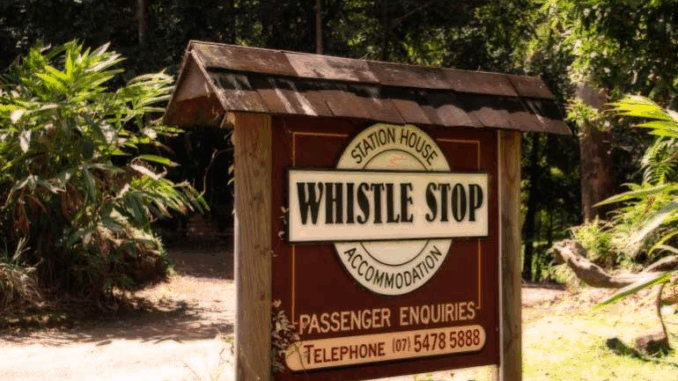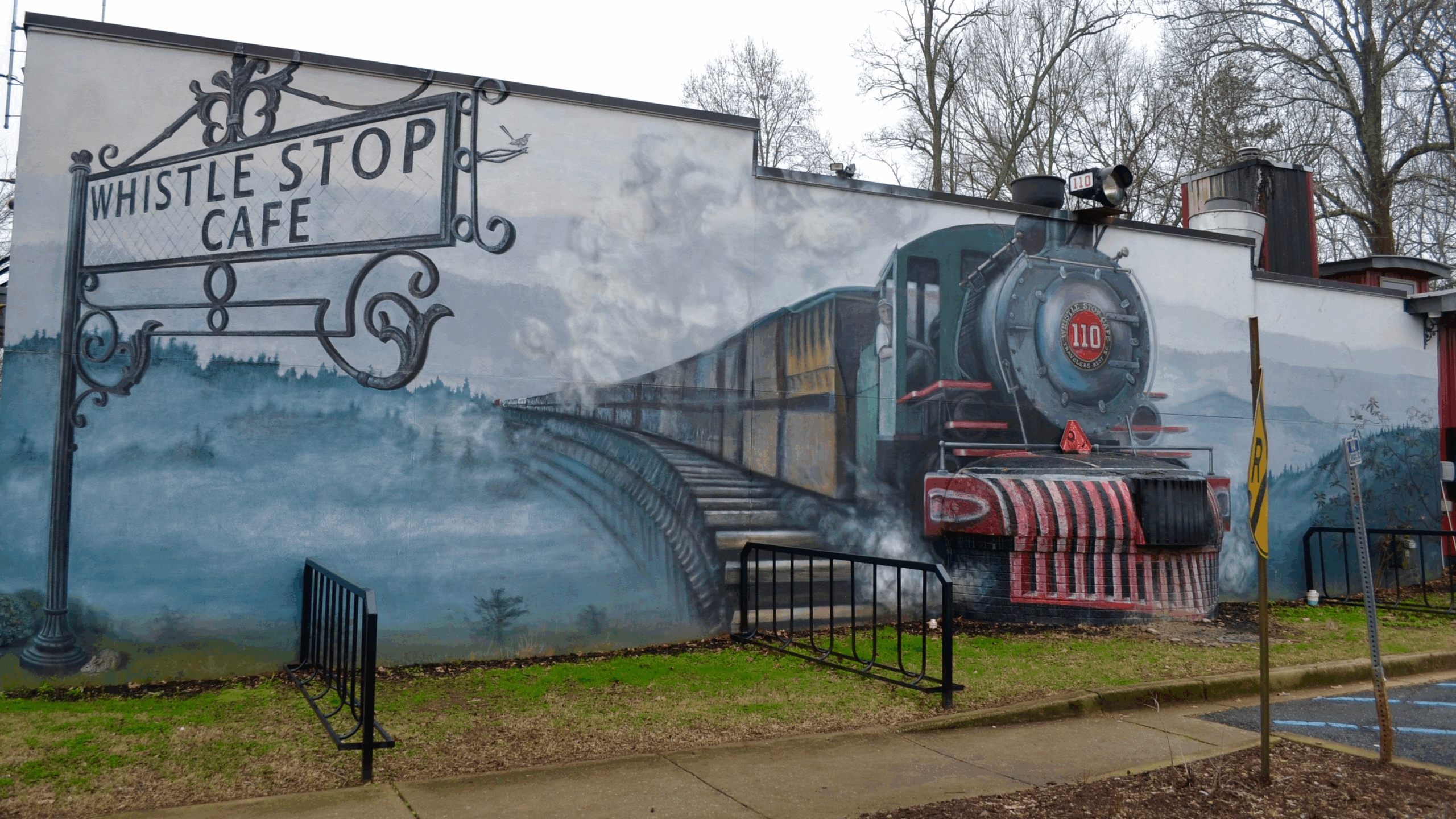
A Café That Became a Character
In Fried Green Tomatoes, the Whistle Stop Café is more than a backdrop—it is the heartbeat of the story. It’s where friendships are forged, secrets are kept, and meals are shared with a side of love and rebellion. It represents comfort, community, resistance, and the sacred ordinary moments of life in a small Southern town.
What many viewers may not know is that the Whistle Stop Café wasn’t just a studio set—it’s a real place. Located in Juliette, Georgia, the café used in the film became a genuine destination long after the cameras stopped rolling. And much like the fictional town of Whistle Stop itself, it has become a symbol of enduring warmth and Southern resilience.
This article takes a closer look at how the Whistle Stop Café came to life, both on screen and off, and why its legacy continues to draw fans more than 30 years after Fried Green Tomatoes first lit up movie screens.
Finding the Perfect Whistle Stop
When director Jon Avnet and his team set out to bring Fannie Flagg’s beloved novel to life, they knew they needed to find a location that didn’t just look Southern—it needed to feel like Whistle Stop. They were searching for something untouched by time, a town where the rhythms of the 1920s and 1930s still echoed in the architecture and atmosphere.
They found what they were looking for in Juliette, Georgia, a small, sleepy community just north of Macon. Before filming began, Juliette was almost forgotten—quiet, unassuming, and mostly bypassed by time. But that made it perfect.
With a bit of set dressing and renovation, Juliette’s old general store was transformed into the Whistle Stop Café. Dirt roads were laid down to replace asphalt, era-specific signage was added, and locals were invited to appear as extras. Suddenly, Juliette wasn’t just a film location—it became Whistle Stop.
Building the Café for Film—and for Life
One of the most fascinating aspects of Fried Green Tomatoes is that the production team didn’t use a fabricated soundstage for the café scenes. They constructed a fully functioning café for the film, complete with a working kitchen, dining area, and outdoor barbecue pit.
The realism paid off. The scenes in the café are some of the film’s most authentic and intimate. You can practically smell the cornbread, hear the sizzle of the frying pan, and feel the sunlight filtering through the wooden shutters.
But what happened after filming wrapped is even more remarkable. Instead of tearing it down, the set remained—and local entrepreneurs decided to open the Whistle Stop Café for real.
Today, fans of the film can dine in the very same building, order fried green tomatoes off the menu, and sit in the same booths where Idgie and Ruth once served their fictional patrons. What started as a movie set became a living tribute to the story and the people who brought it to life.
The Food That Became Legend

Fried green tomatoes had always been a regional Southern dish, but the film gave them international fame. Suddenly, people who had never set foot in Alabama—or Georgia—wanted to taste the crispy, tangy, comfort-food delicacy that gave the movie its name.
At the Whistle Stop Café in Juliette, fried green tomatoes remain the most popular menu item. Made with fresh green tomatoes, cornmeal breading, and served with remoulade or comeback sauce, the dish is more than a meal—it’s a piece of cinema history.
In fact, many fans travel hundreds of miles just to say they’ve eaten the dish in the café that made it famous. It’s not just about the taste—it’s about the experience of stepping into a scene from the film, of sitting where Idgie might have sat, or imagining Big George working the smoker out back.
The Town That Found New Life
Before Fried Green Tomatoes, Juliette was fading. After the local mill closed, jobs and businesses vanished, and many feared the town might disappear altogether. But Hollywood brought not just cameras—but also a second chance.
Since the film’s release in 1991, Juliette has become a small-town pilgrimage site. Fans of the movie come for the café, but stay for the charm. Local shops have sprung up selling Fried Green Tomatoes-themed merchandise, and the town hosts events like “Fried Green Tomato Festival” weekends that draw big crowds.
What’s most touching is how the community embraced its cinematic legacy. Locals who once appeared as extras or helped with production now work in the café or lead walking tours. The film didn’t just put Juliette on the map—it saved it.
Preservation and Tourism: Keeping the Spirit Alive
Over the years, there have been challenges—economic downturns, shifting travel trends, and even the pandemic. But the Whistle Stop Café remains a constant. Staff members take pride in preserving the look and feel of the original set, and many elements from the film remain intact: the wooden porch, the checkerboard tables, even old photos on the walls.
The café’s popularity has also sparked a wider tourism push in the area, encouraging visitors to explore more of Georgia’s historic towns and landscapes. For many, the journey to Juliette becomes a deeper exploration—not just of Fried Green Tomatoes, but of Southern history, food culture, and small-town resilience.
Why It Still Resonates
So why does the Whistle Stop Café continue to draw visitors, year after year?
Part of it is nostalgia, of course. Fried Green Tomatoes is one of those rare films that leaves you with a warm ache in your chest—the ache of having touched something true. Fans want to touch it again.
But it’s more than that. The café represents a world where people care for each other, where food is love, and where even the most damaged hearts can find healing. It’s not just about Idgie and Ruth—it’s about us, and our hunger for belonging, comfort, and redemption.
Eating at the café is a kind of communion. It’s a way of saying, “I remember.” Not just the film, but the feeling it gave us.
A Place Out of Time
Walking into the Whistle Stop Café today feels like stepping into a memory that belongs to someone else—and yet, strangely, it becomes your own. The pace is slower. The food is real. The stories echo in the wood-paneled walls and drift in through the screened windows.
For fans of Fried Green Tomatoes, it’s not just a meal—it’s a journey.
It reminds us that the line between fiction and reality isn’t always as firm as we think. Sometimes, the stories we tell are strong enough to shape the world. Sometimes, they even bring an entire town back to life.
Conclusion: A Landmark Built on Story and Soul
The Whistle Stop Café isn’t just a restaurant. It’s a living memorial to a film that taught generations about love, loyalty, courage, and healing. It’s proof that storytelling matters—not just on screen, but in our neighborhoods, in our kitchens, and in our hearts.
From reel to real, from fiction to fact, the Whistle Stop Café endures. Not because of movie magic, but because it was built on something deeper: community, memory, and the hope that a better life is always possible—one plate at a time.
